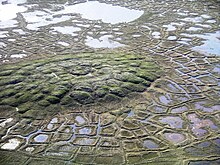

Patterned ground is the distinct and often symmetrical natural pattern of geometric shapes formed by the deformation of ground material in periglacial regions. It is typically found in remote regions of the Arctic, Antarctica, and the Outback in Australia, but is also found anywhere that freezing and thawing of soil alternate; patterned ground has also been observed in the hyper-arid Atacama Desert and on Mars.[2][3] The geometric shapes and patterns associated with patterned ground are often mistaken as artistic human creations. The mechanism of the formation of patterned ground had long puzzled scientists but the introduction of computer-generated geological models in the past 20 years has allowed scientists to relate it to frost heaving, the expansion that occurs when wet, fine-grained, and porous soils freeze.
- ^ Grab, Stefan W.; Gatebe, Charles K.; Kinyua, Antony M. (2004). "Ground Thermal Profiles from Mount Kenya, East Africa". Geografiska Annaler: Series A, Physical Geography. 86 (2): 131–141. Bibcode:2004GeAnA..86..131G. doi:10.1111/j.0435-3676.2004.00219.x. ISSN 0435-3676. JSTOR 3566103. S2CID 129324724.
- ^ Sager, Christof; Airo, Alessandro; Arens, Felix L.; Schulze-Makuch, Dirk (2021-01-15). "New type of sand wedge polygons in the salt cemented soils of the hyper-arid Atacama Desert". Geomorphology. 373: 107481. Bibcode:2021Geomo.37307481S. doi:10.1016/j.geomorph.2020.107481. ISSN 0169-555X.
- ^ "Southern Hemisphere Polygonal Patterned Ground". Mars Global Surveyor: Mars Orbiter Camera. Malin Space Science Systems. Archived from the original on 27 October 2016. Retrieved 8 November 2013.